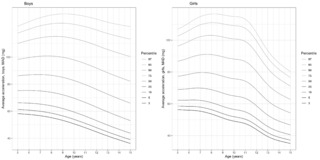Reference values for wrist-worn accelerometer physical activity metrics in England children and adolescents
Fairclough, Stuart J.; Rowlands, Alex V.; del Pozo Cruz, Borja; Crotti, Matteo; Foweather, Lawrence; Graves, Lee E. F.; Hurter, Liezel; Jones, Owen; MacDonald, Mhairi; McCann, Deborah A.; Miller, Caitlin; Noonan, Robert J.; Owen, Michael B.; Rudd, James Robert; Taylor, Sarah L.; Tyler, Richard; Boddy, Lynne M.
Peer reviewed, Journal article
Published version

Åpne
Permanent lenke
https://hdl.handle.net/11250/3098118Utgivelsesdato
2023Metadata
Vis full innførselSamlinger
- Artikler / Articles [2096]
- Publikasjoner fra Cristin [1084]
Originalversjon
International Journal of Behavioral Nutrition and Physical Activity. 20(2023), Artikkel 35. 10.1186/s12966-023-01435-zSammendrag
Background: Over the last decade use of raw acceleration metrics to assess physical activity has increased. Metrics such as Euclidean Norm Minus One (ENMO), and Mean Amplitude Deviation (MAD) can be used to generate metrics which describe physical activity volume (average acceleration), intensity distribution (intensity gradient), and intensity of the most active periods (MX metrics) of the day. Presently, relatively little comparative data for these metrics exists in youth. To address this need, this study presents age- and sex-specific reference percentile values in England youth and compares physical activity volume and intensity profiles by age and sex.
Methods: Wrist-worn accelerometer data from 10 studies involving youth aged 5 to 15 y were pooled. Weekday and weekend waking hours were first calculated for youth in school Years (Y) 1&2, Y4&5, Y6&7, and Y8&9 to determine waking hours durations by age-groups and day types. A valid waking hours day was defined as accelerometer wear for ≥ 600 min·d−1 and participants with ≥ 3 valid weekdays and ≥ 1 valid weekend day were included. Mean ENMO- and MAD-generated average acceleration, intensity gradient, and MX metrics were calculated and summarised as weighted week averages. Sex-specific smoothed percentile curves were generated for each metric using Generalized Additive Models for Location Scale and Shape. Linear mixed models examined age and sex differences.
Results: The analytical sample included 1250 participants. Physical activity peaked between ages 6.5–10.5 y, depending on metric. For all metrics the highest activity levels occurred in less active participants (3rd-50th percentile) and girls, 0.5 to 1.5 y earlier than more active peers, and boys, respectively. Irrespective of metric, boys were more active than girls (p < .001) and physical activity was lowest in the Y8&9 group, particularly when compared to the Y1&2 group (p < .001).
Conclusions: Percentile reference values for average acceleration, intensity gradient, and MX metrics have utility in describing age- and sex-specific values for physical activity volume and intensity in youth. There is a need to generate nationally-representative wrist-acceleration population-referenced norms for these metrics to further facilitate health-related physical activity research and promotion.
Beskrivelse
This article is licensed under a Creative Commons Attribution 4.0 International License, which permits use, sharing, adaptation, distribution and reproduction in any medium or format, as long as you give appropriate credit to the original author(s) and the source, provide a link to the Creative Commons licence, and indicate if changes were made. The images or other third party material in this article are included in the article's Creative Commons licence, unless indicated otherwise in a credit line to the material. If material is not included in the article's Creative Commons licence and your intended use is not permitted by statutory regulation or exceeds the permitted use, you will need to obtain permission directly from the copyright holder. To view a copy of this licence, visit http://creativecommons.org/licenses/by/4.0/. The Creative Commons Public Domain Dedication waiver (http://creativecommons.org/publicdomain/zero/1.0/) applies to the data made available in this article, unless otherwise stated in a credit line to the data.